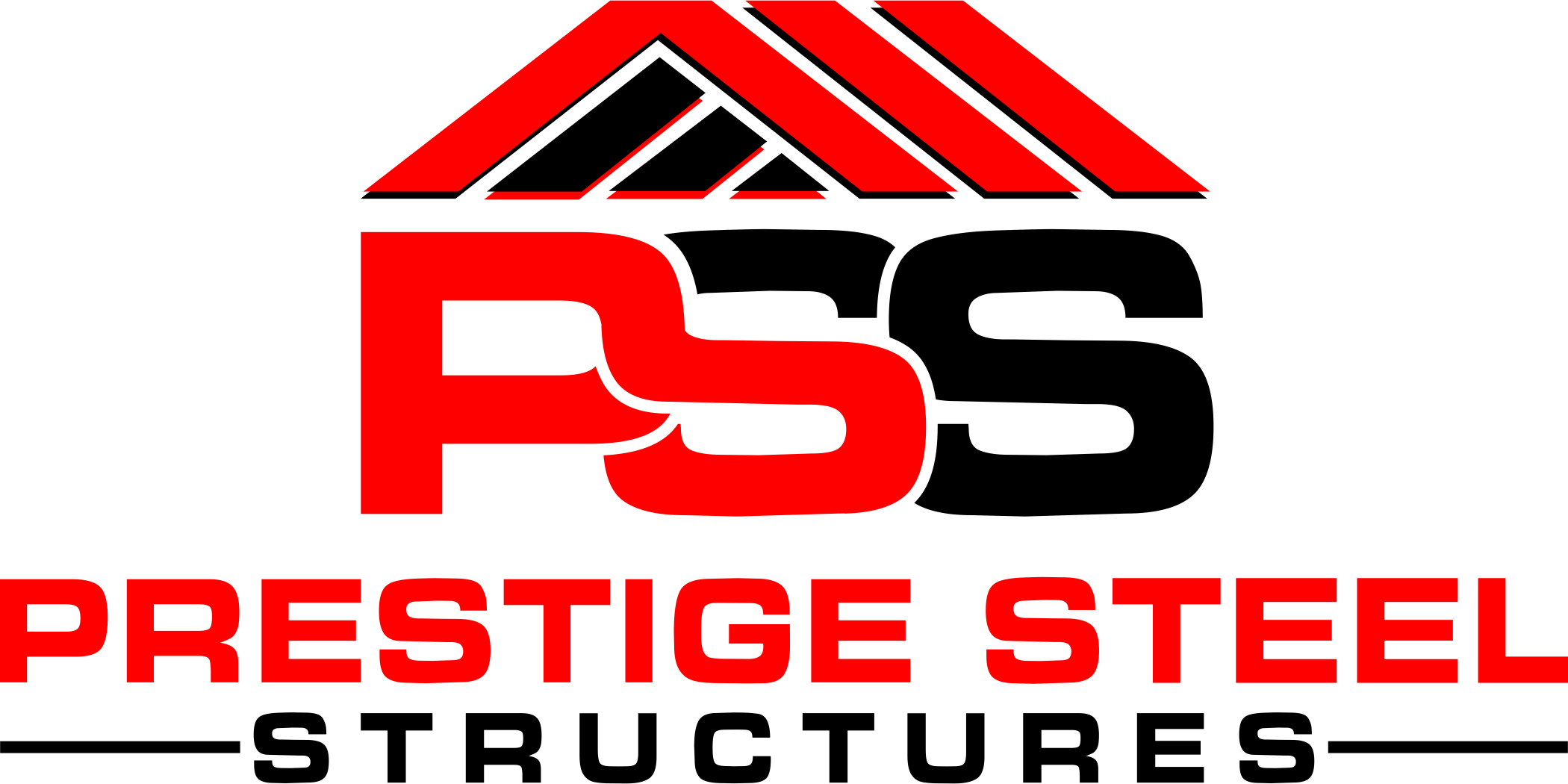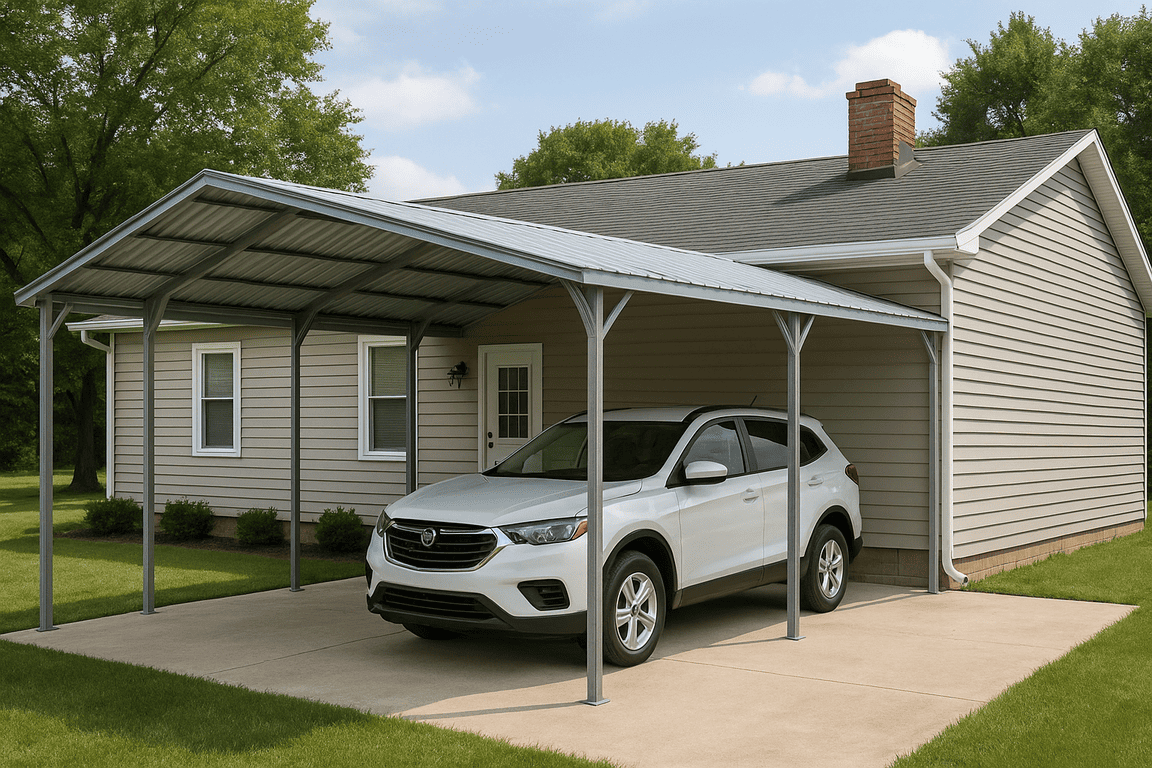Many homeowners worry about adding carports to their homes. They think metal structures won’t match their house style. However, modern carports blend seamlessly with any home design. These structures protect vehicles while staying budget-friendly.
Metal carports offer more benefits than homeowners initially realize. They provide excellent protection from weather and sun damage. Installation is straightforward and doesn’t require major construction work. Professional installers can complete most projects within a single day.
Steel frames form the backbone of quality metal carports. These frames support the roof and ensure long-lasting durability. The metal construction resists rust, rot, and pest damage. Strong steel beams handle heavy snow loads and high winds.
Homeowners can easily upgrade their carports over time. Adding walls transforms open carports into enclosed garages. You can install garage doors for added security. Windows and side entrances create functional workshop spaces. Some designs accommodate RVs while leaving storage room.
Custom carport kits come in many sizes and configurations. Single-car designs work well for compact properties. Double carports protect multiple vehicles or provide extra storage. RV owners can select extra-tall models with wider openings.
Detachable designs offer flexibility for future property changes. Various roof styles match different architectural preferences. Hip roofs complement traditional homes perfectly. Flat or single-slope roofs suit modern house designs. Online carport builders help visualize different options before purchasing.
Professional design tools simplify the customization process. You input your home’s dimensions and style preferences. The software suggests compatible carport designs automatically. This ensures your new structure enhances your property’s appearance.
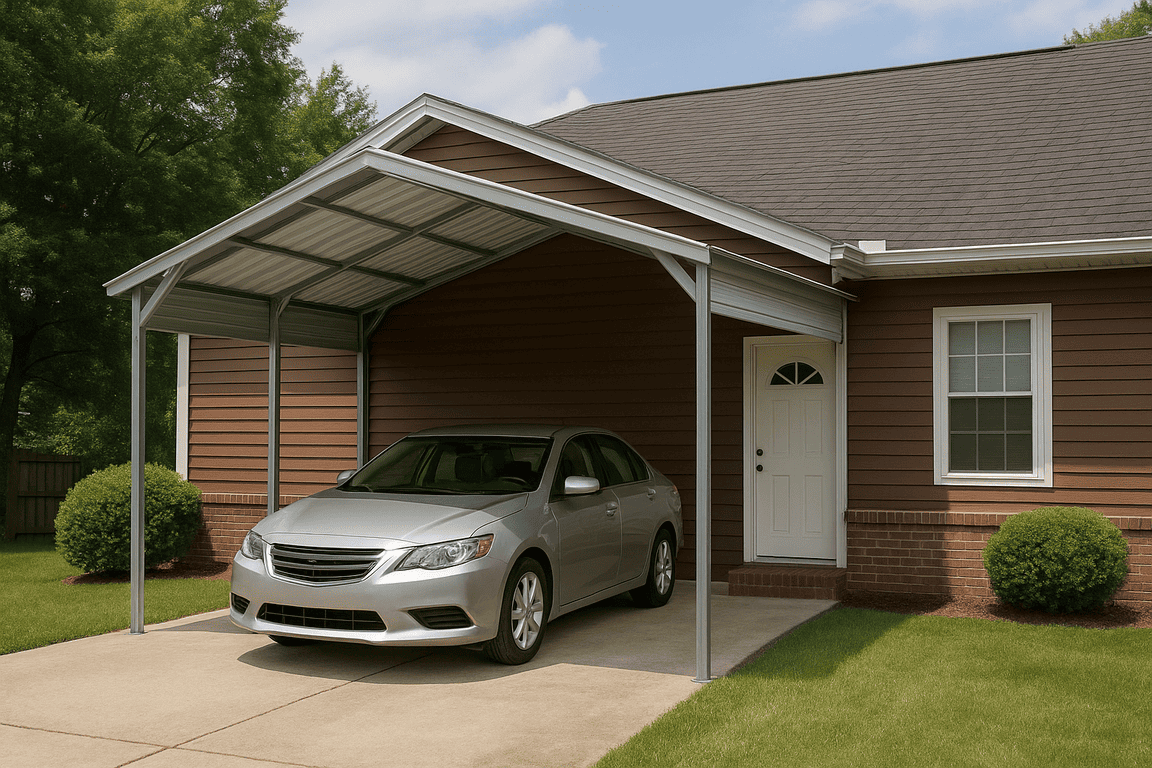
How to Attach Metal Carports to Your House
Metal carports represent smart investments for property owners. These versatile structures adapt to both residential and commercial needs. They serve multiple purposes beyond simple vehicle protection. Long-term savings make them worthwhile additions to any property.
Steel carports offer exceptional flexibility in placement and usage. Homeowners use them for vehicle protection, outdoor workshops, or covered patios. Businesses create loading zones, equipment storage, or customer parking areas. The sturdy construction handles various weather conditions year-round. Their adaptability ensures they meet changing needs over time.
Maintenance costs stay remarkably low with metal carports. Unlike wood structures, steel doesn’t rot or attract termites. The metal surfaces resist rust through protective coatings. Simple cleaning keeps these structures looking new for decades. This durability delivers excellent returns on your initial investment.
Understanding Lean-To Carport Attachment
Lean-to carports attach directly to your home’s existing structure. Your building needs adequate height under the eave for installation. This attachment style uses basic pole-building construction methods. Professional contractors can complete installation quickly and efficiently.
DIY installation saves money on assembly costs. Steel and aluminum carport kits include pre-drilled holes. Pre-cut pieces simplify the construction process significantly. Clear instructions guide homeowners through each installation step. Most projects require only basic tools and minimal experience.
Two main roofing systems offer different aesthetic options. W-pan systems create attractive corrugated ceiling appearances. Flat-pan designs provide smooth, modern ceiling looks. Both options meet local building code requirements. Each system offers equal strength and weather resistance.
Quality steel carports feature superior corrosion resistance. Protective coatings prevent rust and extend structure lifespans. These buildings safely house cars, boats, and tractors. Lawn equipment stays protected from weather damage year-round. Easy access design makes daily use convenient and practical.
Expanding Your Carport’s Purpose
Metal carports adapt as your needs change over time. Today’s vehicle shelter becomes tomorrow’s workshop or storage area. Many homeowners transform carports into entertainment spaces for gatherings. The covered area provides shade for outdoor parties. Weather protection makes these spaces usable year-round.
Heavy machinery and lawn equipment find secure storage underneath. The open design allows easy equipment access. Tool storage keeps everything organized and readily available. Some owners add workbenches for outdoor projects. This versatility maximizes your investment value over time.
Property values often increase with quality carport additions. Potential buyers appreciate covered parking and storage options. Well-designed metal structures enhance curb appeal significantly. The low maintenance requirements attract practical homeowners. Future resale benefits justify the initial investment costs.
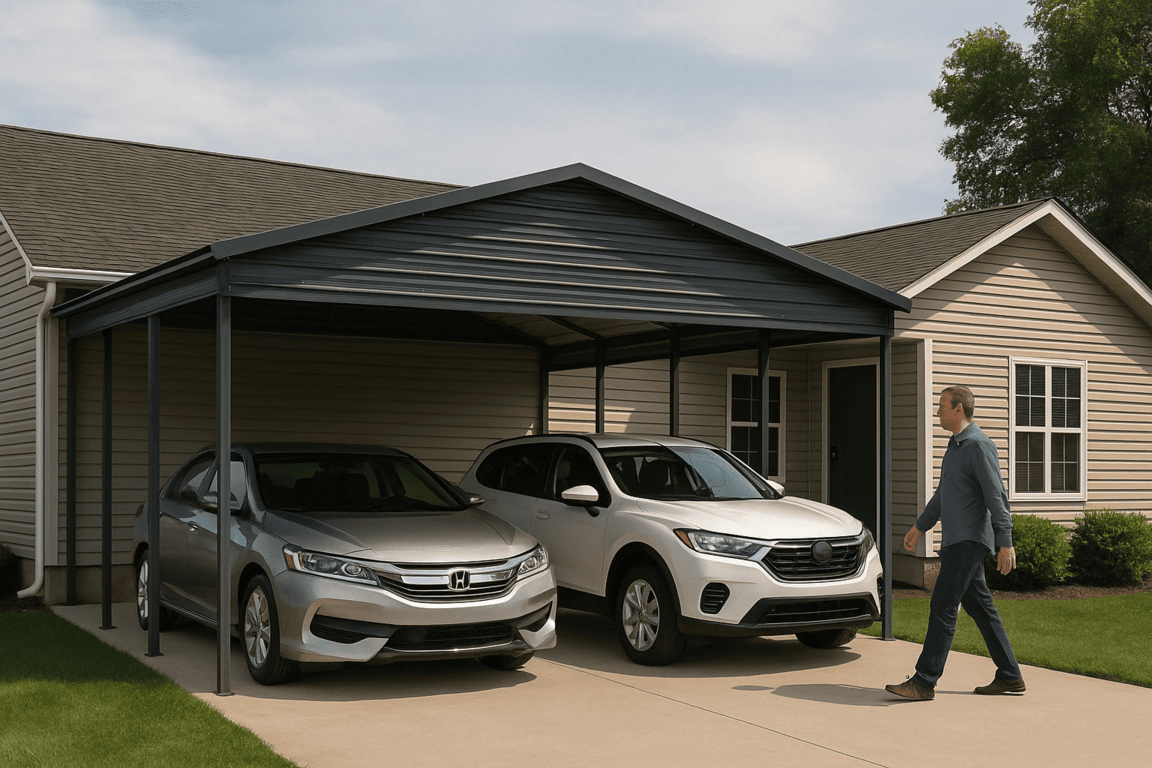
Key Steps for Attaching a Carport to Your House
Attaching a carport requires careful planning and proper execution. The process starts with anchoring a support header. This header connects directly to your home’s existing structure. Proper attachment ensures stability and weather resistance.
Layout planning determines the carport’s final position and appearance. Use string lines to mark the building’s footprint clearly. The triangle method ensures square corners and proper alignment. Drop plumb lines from each side for accuracy. Mark positions for outer support posts carefully.
Preparing the Foundation and Posts
Post hole preparation forms the foundation of your carport. Dig holes deep enough for local frost lines. Your area’s building codes specify required depths. Ensure holes align perfectly with your layout marks. Square alignment with existing structures prevents future problems.
Post installation requires precision and patience for best results. Place posts in holes using temporary braces for support. Check vertical alignment with a spirit level constantly. Pour concrete into tube forms around each post. Allow several days for concrete to cure completely.
Support beam attachment connects posts to create the frame. Clamp beams temporarily while checking horizontal levels. Beam placement determines your carport’s roof slope angle. Secure connections with appropriate screws and brackets. Double-check all measurements before final attachment.
Building the Roof Structure
Rafter installation creates the roof’s structural framework. Measure and mark rafter positions on support beams. Cut rafters to match your predetermined roof angle. An assistant helps position rafters during installation. Secure each rafter with galvanized screws or bolts.
Trim pieces give your carport a finished appearance. Attach trim to rafter ends using finishing nails. Align edges carefully for professional-looking results. Proper trim installation prevents water damage later. Paint or seal trim pieces for weather protection.
Roofing material installation requires methodical work from bottom up. Attach slats or panels starting at the lowest point. Overlap each piece to ensure water runoff. Use galvanized screws to prevent rust problems. Upper pieces should cover lower pieces’ screw heads.
Choosing the Right Anchoring System
Different surfaces require specific anchoring methods for stability. Concrete surfaces work best with wedge or sleeve anchors. Rebar anchors provide excellent holding power in concrete. Drill precise holes for anchor placement and sizing. Tighten anchors according to manufacturer specifications.
Bare ground installations often use auger-style anchors effectively. These anchors twist deep into soil for stability. Mobile home anchors work well in softer ground. Asphalt anchors suit paved areas without concrete foundations. Each anchor type has specific installation requirements.
Level ground ensures your carport stands properly for years. Minor slopes can cause structural stress over time. Grade the area before beginning any construction work. Proper drainage prevents water pooling under your carport. A firm, level base eliminates many future problems.
Legal Requirements and Permits
Building permits are often required for attached carports. Check local building codes before starting your project. Submit plans to your local building department early. Permit requirements vary significantly between different municipalities. Some areas require professional engineer approval for plans.
Gather necessary paperwork well before construction begins. Include detailed drawings showing dimensions and attachment methods. List all materials and their specifications clearly. Photo documentation helps explain your planned project. Starting construction without permits can cause expensive delays.
Professional inspections ensure your carport meets safety standards. Schedule required inspections at appropriate construction stages. Address any concerns inspectors raise immediately. Final approval confirms your carport’s legal compliance. Keep all permits and inspection records for future reference.
Essential Steps to Attach a Metal Carport
Building a carport attachment requires systematic planning and execution. Each step builds upon the previous one carefully. Following proper procedures ensures a sturdy, long-lasting structure. These guidelines help homeowners complete successful carport projects.
Taking Accurate Measurements
Start by measuring the intended carport location precisely. Clear all debris from the construction area first. Level ground makes parking vehicles much easier later. Remove rocks, roots, and any uneven spots. A clean workspace prevents measurement errors and safety hazards.
Measure from your home’s wall to determine carport width. Most single carports measure approximately three meters wide. Double carports require six meters or more. Mark your home’s parallel measurement for carport length. Standard lengths range from six to eight meters.
Place marking pegs at all four corner positions. Drive pegs firmly into the ground for stability. Position hurdles slightly beyond each peg location. These hurdles will support your layout string lines. Accurate peg placement ensures proper carport dimensions.
Setting Up String Lines
Quality string lines create your carport’s visual outline. Stretch lines tightly between hurdles for accuracy. Each line must touch two corner pegs precisely. This creates a perfect rectangular shape outline. Check that lines remain taut throughout the process.
The string rectangle shows your carport’s exact footprint. Remove pegs after confirming the layout looks correct. String intersections mark where concrete footings go. These corners support your carport’s main posts. Mark these spots clearly before proceeding further.
Verifying Square Corners
Diagonal measurements confirm your layout forms perfect squares. Measure from corner to corner in both directions. Equal diagonal measurements indicate square corners perfectly. Unequal measurements mean adjustments are necessary immediately. Shift string lines until diagonals match exactly.
Square corners prevent structural problems during construction. Skewed frames cause roof alignment issues later. Posts won’t fit properly without square corners. Taking time here saves hours of corrections. Professional builders always verify square layouts carefully.
Digging Post Holes
Excavate holes at each marked corner location precisely. Hole depth depends on your local soil conditions. Sandy soil requires deeper holes than clay. Rocky soil may need special drilling equipment. Follow local building codes for minimum depths.
Keep excavated soil nearby for later backfilling. Dig holes slightly wider than post dimensions. This extra space allows concrete to surround posts. Clean hole edges prevent soil cave-ins. Check depths frequently while digging each hole.
Pouring Concrete Foundations
Mix concrete according to package directions carefully. Pour concrete into holes until half full. Insert post saddles into wet concrete immediately. Push saddles 25 millimeters below surface level. This depth provides proper post support.
Center each saddle in its hole precisely. Use a level to ensure saddle alignment. Wet concrete allows position adjustments easily. Work quickly before concrete begins setting. Let concrete cure according to manufacturer recommendations.
Installing Posts Properly
Post installation requires an assistant for best results. One person holds posts perfectly vertical steadily. The other person checks alignment with spirit levels. Vertical posts ensure proper carport structure integrity. Even slight angles cause major problems later.
Drill through saddle holes into each post carefully. Insert coach bolts through drilled holes completely. Add washers and nuts to secure connections. Tighten bolts firmly but avoid over-tightening. Check post alignment again after securing bolts.
Double-check all posts remain perfectly vertical. Make final adjustments before concrete fully hardens. Temporary braces help maintain post positions overnight. Remove braces only after concrete cures completely. Proper post installation ensures decades of reliable service.
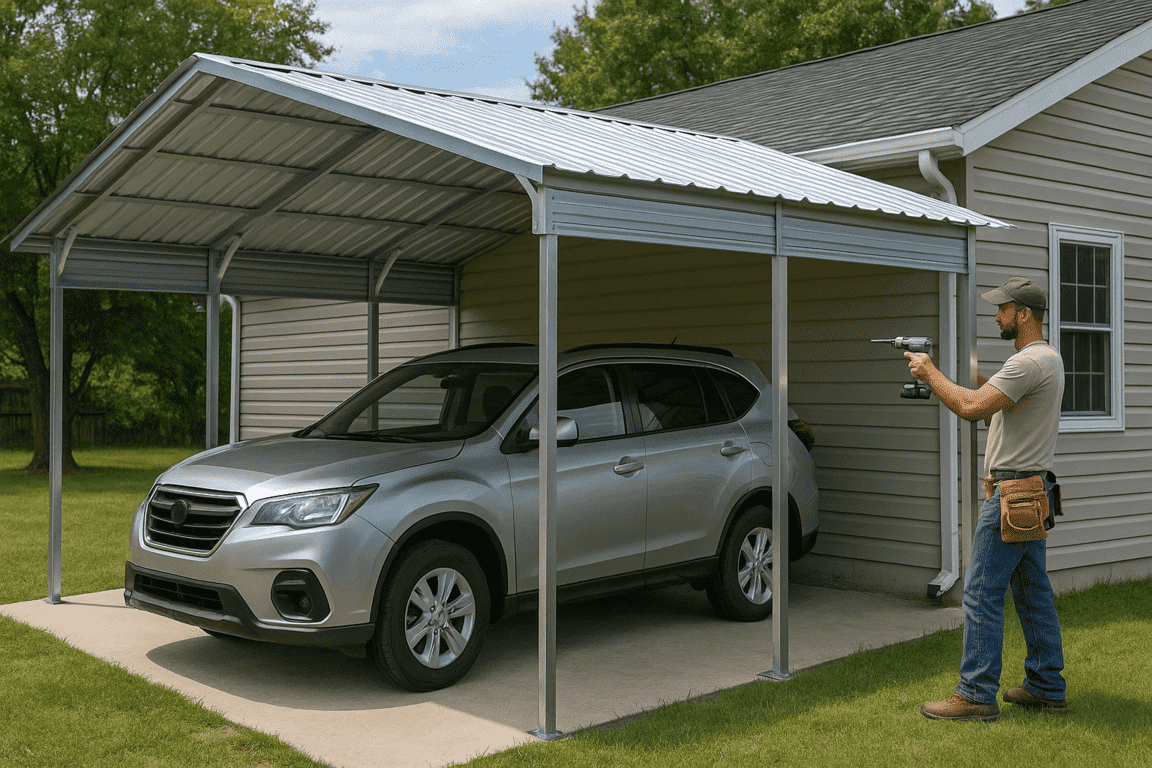
Understanding Carport Construction Planning
Building an attached carport requires careful planning and consideration. Various factors influence the overall project scope significantly. Understanding each component helps you prepare adequately. Smart planning ensures successful project completion.
Important factors include unit size and selected features. Site preparation affects the construction timeline considerably. Building permits require advance planning and documentation. Concrete slabs and paint colors need early decisions. Each element contributes to your project’s success.
Carports provide excellent value for homeowners. They protect vehicles from harsh weather conditions effectively. The covered space serves multiple purposes beyond parking. Many homeowners use carports as workshops or storage. This versatility makes them worthwhile home improvements.
Carport Sizes and Options
Single-car carports measure 12 to 20 feet typically. These compact structures suit most residential needs perfectly. Design variations accommodate different architectural styles. Basic models offer essential protection and functionality. Premium designs include additional features and stronger materials.
Two-car carports provide 20 feet of coverage space. These larger structures accommodate most family vehicle needs. Side-by-side parking makes daily use more convenient. Extra space allows for storage along the sides. Many families find this size most practical.
Three-car carports measure 20 by 30 feet minimum. These spacious structures easily accommodate SUVs and trucks. Additional room provides workshop space between vehicles. Large families appreciate the extra parking capacity. The added space increases property functionality significantly.
RV carports require substantial space and sturdy construction. Standard dimensions start at 20 by 30 feet. Height clearance must accommodate tall recreational vehicles. Reinforced frames handle the extra structural demands. Special considerations ensure proper RV protection and access.
Material Options Available
Metal carports dominate the market for good reasons. Steel and aluminum offer exceptional durability and longevity. These materials resist weather damage and require minimal maintenance. Open-sided designs maximize ventilation and accessibility. Various styles include freestanding, attached, and portable options.
Polycarbonate carports blend modern aesthetics with functionality. These translucent panels resist weather damage effectively. UV protection prevents sun damage to vehicles. The lightweight material simplifies installation processes. Many homeowners appreciate the contemporary appearance.
Wood carports provide traditional charm and customization options. Different wood types offer various aesthetic appeals. Cedar and redwood naturally resist insects and decay. Pressure-treated pine provides economical alternatives. Regular maintenance keeps wood carports attractive longer.
Additional Planning Considerations
Foundation work significantly impacts your project timeline. Concrete slabs ensure level, stable carport bases. Professional installation guarantees proper drainage and longevity. Site preparation may require grading or excavation. These services need scheduling well in advance.
Roofing materials vary widely in style and performance. Metal roofs offer long-lasting weather protection. Polycarbonate roofing provides natural lighting benefits. Traditional shingles match existing home aesthetics. Each material provides different advantages.
Attachment methods influence overall project complexity considerably. Attached structures integrate seamlessly with existing homes. Freestanding models offer placement flexibility. Portable carports allow future relocation if needed. Your choice depends on property layout and needs.
Building permits add necessary steps to your timeline. Local requirements vary by jurisdiction and project scope. Council permissions may require additional documentation and reviews. Professional drawings might be necessary for approval. Start permit processes early to avoid delays.
Labor requirements depend on project complexity and size. Professional installation ensures code compliance and quality. DIY installation requires significant time and skill. Consider your abilities honestly before choosing. Proper installation ensures decades of reliable service.
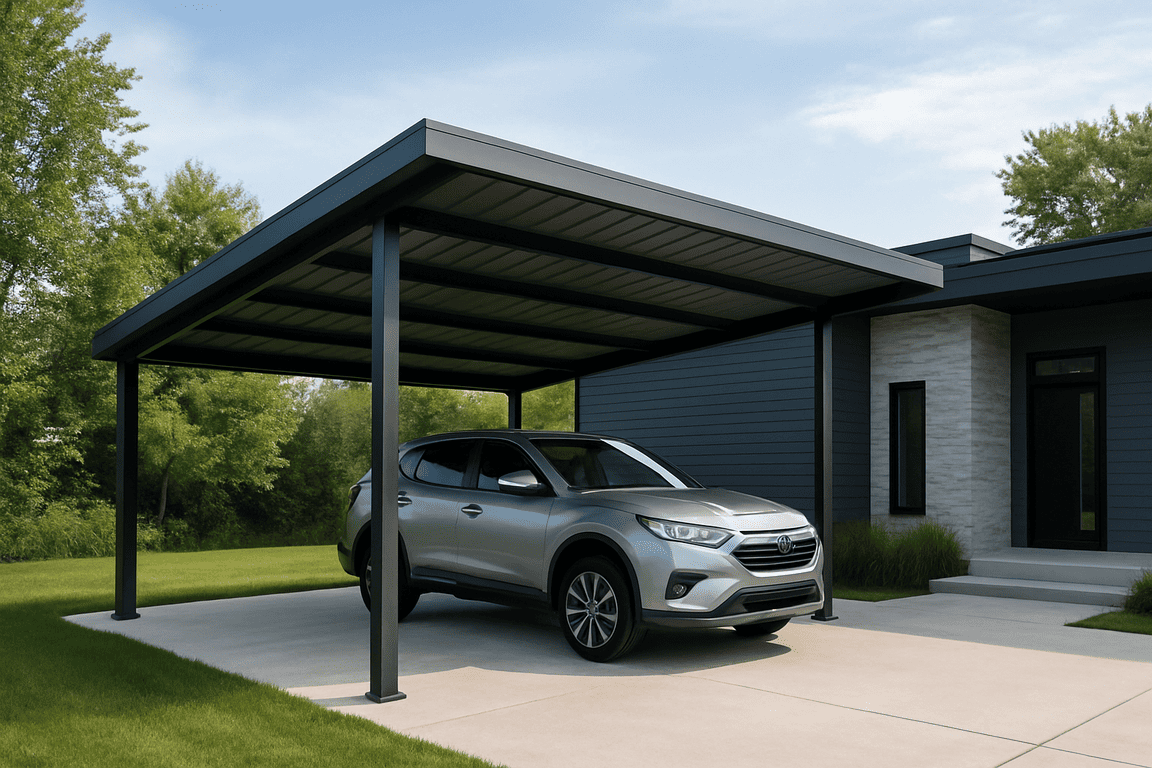
Creative Design Ideas for House-Attached Carports
Transform unused backyard or front areas into functional parking spaces. Carports offer open-style designs for easy vehicle access. These structures feature supportive beams and protective roofing. They provide practical alternatives to expensive traditional garages. Metal carports accommodate multiple vehicles including RVs and boats.
Contemporary Wooden Slat Design
This striking design combines horizontal wooden slats with aluminum panels. The structure creates an appealing and sophisticated parking area. Side panels provide privacy while protecting vehicles effectively. Weather protection prevents damage from rain and debris. The modern aesthetic enhances your home’s overall appearance.
Wooden slats offer natural warmth and visual interest. Aluminum components ensure long-lasting durability and minimal maintenance. The horizontal design creates clean, contemporary lines. Privacy panels shield vehicles from prying eyes. This design suits modern and transitional home styles perfectly.
Home Extension Carport
Integrate your carport seamlessly with existing home architecture. This design approach creates visual cohesion throughout exterior spaces. Extended structures provide abundant parking and storage options. Horizontal beams double as overhead storage for boats. The unified design enhances property value significantly.
Extension designs make carports feel like natural home additions. Matching materials and colors ensure architectural harmony. Additional functionality transforms simple parking into multipurpose spaces. Smart planning maximizes both form and function. These designs work especially well with ranch-style homes.
Rustic Cabin Style
Embrace countryside charm with rustic cabin-inspired carport designs. Red shingle roofing creates traditional appeal and character. Wooden posts add authentic cabin aesthetics throughout. Electric connections enable easy conversion to pavilion spaces. Decorative lighting enhances evening ambiance and security.
This design suits mountain homes and rural properties beautifully. Natural materials blend with surrounding landscapes effortlessly. The versatile structure serves multiple outdoor entertainment purposes. Rustic elements create warm, inviting spaces year-round. Customizable features allow personal style expression.
Barn-Style Carport
Enclosed barn-style carports offer maximum storage and protection. These structures easily accommodate two vehicles without doors. Tall rooflines provide vertical storage for bikes and equipment. Car lifts fit comfortably within the generous height. Breezeway connections integrate carports with main houses.
Epoxy floor coatings simplify cleaning and maintenance tasks. The barn aesthetic complements farmhouse and country home styles. Open access maintains convenience while providing weather protection. Additional storage space reduces household clutter effectively. This design maximizes functionality without sacrificing style.
Pergola-Style Design
Draw inspiration from classic pergola architecture for carports. Evenly spaced thick beams create distinctive visual patterns. Pitched roofs ensure proper water drainage away from foundations. Gutter systems prevent water accumulation and damage. The design balances open-air feeling with protective coverage.
Pergola-style carports suit Mediterranean and tropical home designs. Natural wood finishes enhance outdoor living spaces beautifully. The structure provides partial shade while maintaining airflow. Climbing plants can add natural beauty over time. This style creates resort-like atmospheres at home.
Modern Marvel Design
Contemporary carport designs transcend basic vehicle storage needs. These structures become architectural features enhancing home aesthetics. Weekend entertainment spaces emerge from thoughtful design planning. Modern materials and clean lines create sophisticated appearances. Landscape elements remain focal points despite new structures.
Minimalist designs emphasize function without overwhelming existing architecture. Glass and steel components add industrial chic appeal. LED lighting systems create dramatic evening effects. These carports increase property values through design excellence. Modern marvels prove carports can be design statements.
Mediterranean Aesthetic
Stand out with Mediterranean-inspired carport designs featuring distinctive elements. Red-tiled shingles echo traditional Spanish and Italian architecture. Plaster walls and rustic wood trim complete the look. This style provides shelter while maintaining regional character. Children and pets enjoy additional covered outdoor space.
Mediterranean designs work wonderfully in warm climate regions. Textured surfaces add visual interest and authenticity. Earth tone colors blend naturally with landscapes. The style creates vacation-like atmospheres at home. These carports become neighborhood conversation pieces.
Craftsman Style Carport
Craftsman carports showcase exceptional woodworking and architectural details. Exposed beams highlight quality construction and materials. Decorative brackets add artistic elements to functional structures. Heavy overhead beams emphasize traditional craftsmanship values. These designs accommodate everything from cars to boats.
The style complements Craftsman, Prairie, and bungalow homes perfectly. Natural wood stains preserve material beauty and character. Built-in storage solutions maximize space efficiency. Weather-resistant construction ensures decades of reliable service. Craftsman carports become treasured home features.
Solar-Powered Innovation
Modern carports incorporate sustainable technology through solar panel integration. Rooftop panels generate clean energy for household use. Electric vehicle charging stations utilize solar power directly. This design reduces utility costs while protecting vehicles. Multiple benefits justify the initial investment quickly.
Solar carports represent forward-thinking home improvement choices. Environmental consciousness meets practical vehicle protection needs. Government incentives may offset installation costs significantly. The technology appeals to eco-conscious homeowners increasingly. Future-ready designs prepare homes for electric vehicle adoption.
Additional Design Options
Portable carports offer flexibility for temporary needs. These structures install and remove quickly as required. Outdoor adventures benefit from portable shelter options. Setup requires minimal effort and no permits. Cost-effective solutions suit budget-conscious homeowners.
Bungalow-style designs feature chevron roofs and hanging plants. Green elements create inviting, natural environments. Storage compartments keep equipment organized and accessible. Wooden posts provide sturdy support against weather. These designs blend functionality with garden aesthetics.
Gated carports add security for valuable vehicles. Steel and wood combinations ensure strength and beauty. Lock systems protect against theft and vandalism. Corrosion-resistant materials maintain appearance over time. Security features provide peace of mind for owners.

Planning to Add a Carport to Your Property?
Prestige Steel Structures has built quality carports for many years. The company creates carports using various materials and designs. Customers can choose from many colors and custom options. This trusted business goes beyond just building carports.
The company sells complete material sets and installation tools. You don’t need to shop at multiple stores. Prestige Steel Structures provides everything needed for carport projects. We also have experienced builders ready to help. Whether for homes or offices, they handle all projects. Our services remain affordable for most budgets.
This extensive experience helps them understand each customer’s needs. We work closely with clients to create ideal solutions. Prestige Steel Structures offers many outdoor storage options. These include RV covers, garages, and metal barns. We also provide portable garages and storage solutions.
Some companies sell do-it-yourself garage kits too. These kits let homeowners build without professional help. All products meet high quality standards. Setup and removal processes are straightforward and simple. The engineering behind each product ensures durability. Contact Prestige Steel Structures for new installations. They also handle upgrades to existing carports.
Conclusion
Attaching a metal carport to your home offers practical benefits and value. These structures protect vehicles while enhancing your property’s functionality. Modern carports blend seamlessly with various architectural styles and designs. They provide affordable alternatives to traditional garage construction projects.
Professional installation ensures proper attachment and long-lasting performance for years. Quality materials resist weather damage and require minimal maintenance. Customization options let you match your home’s existing aesthetic. Building permits and proper planning guarantee safe, code-compliant installations.
Whether you need simple vehicle protection or multipurpose outdoor space, carports deliver. They adapt to changing needs and increase property values. Smart design choices transform basic parking into attractive home features. Contact experienced builders like Prestige Steel Structures for expert guidance. Their knowledge helps create the perfect carport for your needs. Start planning your carport project today for better vehicle protection.
Frequently Asked Questions
Can I attach a metal carport to any type of house?
Yes, metal carports can attach to most house types successfully. Your home needs adequate wall height for proper attachment. Professional installers assess your home’s structure before beginning work. They ensure the attachment method suits your specific building materials. Wood, brick, and vinyl siding all accommodate carport attachments. Some homes may require additional reinforcement for secure connections.
Do I need a building permit for an attached carport?
Most areas require permits for attached carport installations. Check with your local building department before starting construction. Permit requirements vary based on size and attachment method. Submit detailed plans showing dimensions and connection points clearly. Professional contractors often handle permit applications for their clients. Starting without permits can result in fines and removal.
How long does carport installation typically take?
Professional teams usually complete carport installation within one day. Larger or complex designs may require two days maximum. Site preparation and concrete work add time to projects. DIY installations take considerably longer than professional jobs. Weather conditions can affect outdoor construction schedules significantly. Most standard carports install quickly with experienced crews.
What maintenance does a metal carport require?
Metal carports need minimal maintenance compared to wood structures. Annual cleaning removes dirt and debris from surfaces. Check for loose bolts or connections twice yearly. Touch up any scratches to prevent rust formation. Apply protective coatings every few years as needed. Proper maintenance extends your carport’s lifespan significantly.
Can I convert my carport into an enclosed garage later?
Yes, many carport designs allow future wall additions easily. The existing frame supports wall panels and doors. Professional contractors can complete conversions without major reconstruction work. Plan for this possibility when choosing your initial design. Electrical and window additions integrate smoothly into conversions. This flexibility makes carports excellent long-term investments.

